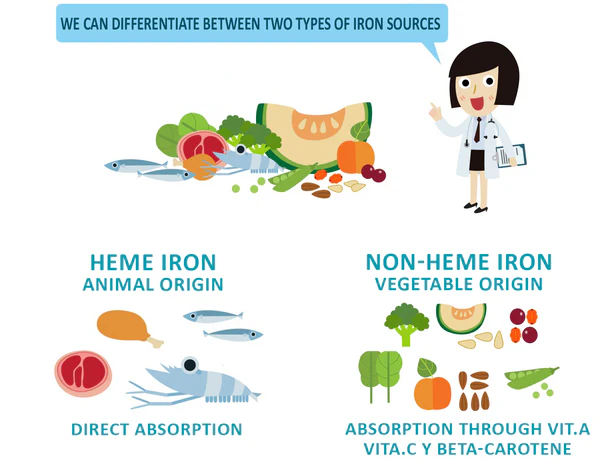ron is an essential nutrient that plays a critical role in oxygen transport, energy metabolism, and immune function. But not all iron is created equal. In 2025, increasing research has drawn attention to a specific form—heme iron, found primarily in red meat and animal products—as a significant contributor to chronic diseases such as type 2 diabetes (T2D) and colorectal cancer (CRC).
Contents
ToggleWhat Is Heme Iron, and How Is It Different?
Iron in our diet comes in two forms:
-
Heme Iron: Found in animal-based foods—particularly red meat, poultry, and seafood. It is absorbed more efficiently by the body.
-
Non-Heme Iron: Found in plant-based foods like lentils, beans, spinach, and fortified cereals. It requires vitamin C or other enhancers for better absorption.
While heme iron is more bioavailable, this convenience may come at a cost.
The Link Between Heme Iron and Type 2 Diabetes: A Metabolic Red Flag
📊 Key 2025 Data from Harvard Study:
A 36-year longitudinal study involving over 206,000 adults showed a 26% increased risk of developing T2D among participants with the highest heme iron intake.
Unlike previous research, this landmark study integrated:
-
Epidemiological data
-
Conventional biomarkers (e.g., insulin, blood sugar, C-peptide)
-
Advanced metabolomics (analyzing thousands of small molecules in the blood)
🔬 Mechanisms Identified:
-
Elevated inflammatory markers: C-reactive protein (CRP), leptin
-
Insulin resistance indicators: Higher C-peptide, triglycerides
-
Depletion of protective biomarkers: HDL cholesterol, adiponectin
-
Presence of diabetes-related metabolites: L-valine, uric acid, lipid metabolites
🩺 Health Implications:
Excess heme iron contributes to metabolic dysfunction, which is a precursor to T2D. The body lacks a regulated excretion system for iron, and chronic overload, especially from animal sources, can lead to oxidative stress and inflammation.
Heme Iron and Colorectal Cancer: A Well-Established Carcinogenic Link
📚 Meta-Analysis Overview (566,000+ participants):
-
Relative Risk (RR) of CRC from high heme iron intake: 1.18
-
Consistent findings across multiple prospective cohort studies
-
Stronger associations when calcium intake was low (a known inhibitor of heme-induced cytotoxicity)
🧪 Biological Mechanisms Behind the Risk:
-
Endogenous Formation of N-Nitroso Compounds (NOCs):
-
Heme iron catalyzes the formation of carcinogenic NOCs in the gastrointestinal tract.
-
Human and animal studies show significantly higher levels of NOCs in the feces of red meat consumers compared to vegetarians.
-
-
Lipid Peroxidation and DNA Damage:
-
Heme iron promotes the formation of reactive aldehydes like malondialdehyde (MDA) and 4-hydroxynonenal (4-HNE).
-
These byproducts damage DNA and suppress apoptosis in cells with mutations in key tumor-suppressor genes like p53 and Apc.
-
-
Promotion of Aberrant Crypt Foci (ACF):
-
Experimental rat studies showed a direct correlation between dietary heme concentration and the development of ACF, considered early indicators of colon cancer.
-
Why This Matters in 2025: Emerging Trends and Public Health Implications
🌱 Plant-Based Meat Alternatives: A Double-Edged Sword
Many plant-based meats (e.g., Impossible™ Burger) include synthetic heme (soy leghemoglobin) to replicate the flavor and texture of real meat. While effective for taste, the health impacts remain under-researched.
⚠️ Caution: Early evidence suggests that synthetic heme may induce similar metabolic and genotoxic effects as animal-derived heme. More long-term, peer-reviewed studies are urgently needed.
🌍 Global Relevance and Equity in Research
The majority of large-scale cohort studies have been conducted in predominantly white populations. Expanding research across different ethnic groups is essential to determine how heme iron impacts diverse genetic and lifestyle profiles.
🧠 Consumer Confusion and Labeling Gaps
Despite growing awareness, most consumers don’t differentiate between heme and non-heme iron on nutrition labels. In 2025, clear labeling of heme content in food products could empower better decision-making.
Practical Guidelines for Safer Iron Consumption
✅ Reduce Intake of Red and Processed Meats
The World Cancer Research Fund and Harvard researchers recommend limiting red meat to no more than 350–500 grams (cooked weight) per week and avoiding processed meat altogether.
✅ Balance Your Diet with Non-Heme Sources
Include iron-rich plant foods:
-
Lentils, chickpeas, tofu
-
Leafy greens (e.g., kale, spinach)
-
Fortified cereals and grains
-
Nuts and seeds
Tip: Pair with vitamin C-rich foods (like citrus or bell peppers) to boost absorption.
✅ Protective Pairings Matter
Emerging research shows that calcium, chlorophyll, and polyphenols (from foods like yogurt, spinach, or red wine) can mitigate the negative effects of heme iron.
🧪 Evidence-Based Hack: “Eat a yogurt after your steak” may be more than folklore—it’s a potential cancer-prevention tactic.
Frequently Asked Questions (FAQs)
❓ Is heme iron bad for everyone?
No, moderate amounts are essential, especially for those at risk of iron deficiency. However, chronic high intake, particularly from processed or red meats, poses health risks.
❓ Can I get enough iron from plants?
Yes, especially with a balanced diet that includes enhancers like vitamin C. Iron from plant sources is safer in the long term and doesn’t carry the same disease risks.
❓ Are plant-based meats with added heme safe?
Current research is inconclusive. Proceed with caution and treat them like conventional red meat until more is known.
Conclusion: Rethinking Iron in a Modern Context
Iron is vital, but the source matters. In 2025, evidence has reached a tipping point: high heme iron intake—particularly from red and processed meats—is a modifiable risk factor for both type 2 diabetes and colorectal cancer. With chronic diseases on the rise globally, the focus must shift from not just what we eat, but how our food interacts with our biology.
For consumers, that means making smarter choices: favor plant-based iron sources, reduce processed meat intake, and consider nutrient combinations that protect against iron-induced damage. For policymakers and food manufacturers, it’s time to promote transparency, fund diverse population studies, and innovate safer alternatives.
